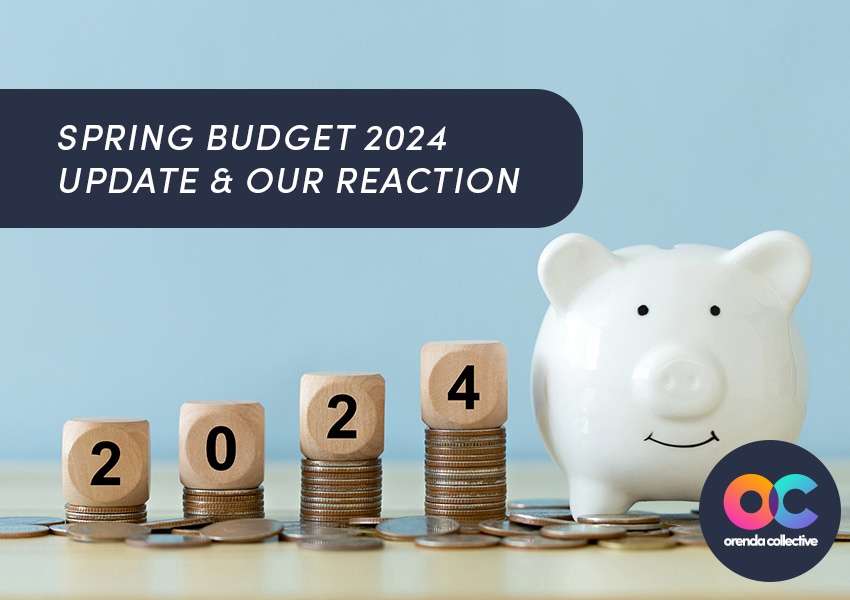
On March 6th, 2024, the government unveiled their Spring 2024 budget. There are many different topics covered in the budget such as public spending, housing, transport, investments etc., so it can be difficult to pinpoint those changes that are relevant to you. Here, we intend to summarise the most relevant updates for individuals and small businesses.
Reduction in National Insurance
After reducing the main National Insurance rate by 2% in Autumn, individuals paid via PAYE will experience another 2% cut, bringing the rate down from 10% to 8% starting April 6, 2024. According to the government estimates, the combined effect of these two national insurance rate cuts would save a worker earning £35,400 over £900 annually.
Taken together these cuts mean:
• an average full-time nurse on £38,900 will receive an annual gain of over £1,000
• an average teacher on £44,300 will receive an annual gain of over £1,250
• an average police officer on £44,300 will receive an annual gain of over £1,250
• a typical junior doctor on £65,000 will receive over £1,500
• and working families with two earners each on the average salary will receive a gain of over £1,800.
Self-employed individuals will also enjoy a national insurance cut, reducing from 8% to 6% (previously 9% for 2023/24). This combined with the abolition of Class 2 NICs altogether would save a self-employed person with taxable profits of £28,000 around £650 per year.
Reaction:
Although it’s positive for those employed or self-employed, we hoped for adjustments to tax-free allowances and brackets in the budget.
The tax-free allowance will remain at £12,570 for the 2024/25 tax year as will the basic rate of tax threshold which is £50,270 (where it has been since 2021/22), this creates ‘fiscal drag’, which is a term that describes the process of pulling more people into paying income tax and pushing others into a higher tax band.
Traditionally tax brackets are adjusted to keep pace with inflation; however, they have been frozen in cash terms since April 2021. This means that as incomes rise, more low earners are pulled into paying the 20% basic-rate income tax (which kicks in at £12,571) and those with earnings nearing £50,000 tip into the higher 40% rate (which kicks in at £50,271).
The government budget lacked substantial support for small, limited companies, despite SMEs constituting 61% of all private sector, meaning that more than 3 in every 5 people are employed in the UK private sector.
Corporation tax rates are at their highest in over 10 years and this coupled with increased minimum wage amounts means that small businesses are under increasing pressure, which is likely in turn to mean that those employed by small businesses are also impacted.
Capital Gains Tax
In an attempt to raise revenue and boost the availability of housing by encouraging residential property disposals, the government has decreased the higher rate of capital gains tax levied on sales of residential property from 28% to 24%.
Previously, basic rate taxpayers would pay tax at 18% on disposals of residential properties whilst higher rate taxpayers would pay 28%. The basic rate of 18% remains the same but higher rate taxpayers will pay 24% from 6 April 2024.
Sales of a main residence are not within the charge of Capital Gains tax, so this only applies to sales of additional residential properties owned.
Reaction:
It will be interesting to see the impact (if any) this has on house prices, and whether it translates to any respite for those renting who have been seeing ever increasing rent prices over previous years.
VAT registration threshold
From 1 April 2024 the VAT registration threshold will be increased from £85,000 to £90,000. This means a business’s 12 month rolling turnover now needs to reach £90,000 for it to be required to register for VAT and begin charging VAT on its taxable supplies.
The de-registration limit has now increased from £83,000 to £88,000 meaning if a VAT registered business’s turnover falls below £88,000 and they do not expect it to breach this threshold within at least the next 12 months then it can de-register from VAT.
The government predicts this will help 28,000 small businesses in 2024/25 from no longer needing to be VAT registered.
Reaction:
The increase to the VAT threshold will be helpful for those hovering around the current £85,000 threshold as they will now be able to increase sales by £5,000 before the need to register.
However, historically the VAT threshold was increased broadly in line with inflation, that was until 2017 when it was frozen. If inflationary increases had persisted, the VAT registration threshold would be approximately £108,000. The change in policy led to a steady increase in the number of businesses within the VAT system, therefore increasing the burden.
We see firsthand that some businesses manage their turnover in order to remain below the VAT threshold. This has the unwelcome effect of deterring business growth, as well as impacting on business owners’ living standards.
While businesses breaching the threshold and registering for VAT will be able to recover VAT on eligible costs, they may not be in a position to simply add 20 per cent to their prices, meaning they may have to absorb some of the VAT cost themselves, so would be worse off as a result. This issue is the most acute in the business to consumer (B2C) space, particularly domestic service suppliers such as plumbers, electricians, hairdressers etc.
High Income Child Benefit Charge
The government has now recognised that it is not fair that a household with two parents each earning £49,000 a year will receive child benefit in full, while a household earning less overall but with one parent earning over £50,000 will see some or all their benefit withdrawn.
The changes to the system have not yet been enacted, they expect them to be in place from April 2026.
In the meantime, the income threshold individuals can earn before they start losing their entitlement to child benefit is increasing from £50,000 to £60,000.
The taper has also been slowed so individuals only lose full child benefit if their income is above £80,000. Previously, child benefit entitlement was decreased by 1% for every £100 earned above the limit, now it is reduced by 1% for every £200 earned above the limit.
This does still mean that a household of two adults with children where one earns £80,000 and the other earns nothing would lose their child benefit entitlement completely, but a household with two adults with children earning £60,000 each will be entitled to full child benefits.
Overall, the government estimates 485,000 families will gain an average of £1,260 in Child Benefit in 2024-25 as a result of these changes.
Reaction:
We are very much in favour of a move to a household approach and are baffled an individual approach was ever introduced. It is however disappointing that this does not look likely to take effect until April 2026.
New British ISA
To improve the competitiveness of the UK’s capital markets and unlock more private capital for the UK’s growth industries, the government is launching a new UK ISA to support savers and open up new investment opportunities for individuals.
The UK ISA will have a £5,000 contribution allowance, which is in addition to the current £20,000 ISA investment limit per tax year.
The government will consult on the details so further specific details are expected in the coming months.
Reaction:
We are all for increased offerings of tax efficiencies on savings and we welcome further details of the ISA so that we can explore using them with our clients.
Furnished Holiday Lettings relief abolished
For a rental property to qualify as a Furnished holiday Let (FHL) the property must be available for letting for at least 210 days a year, it must be actually let for at least 105 days a year and the total of all lettings that exceed 31 continuous days must be no more than 155 days during the year.
Previously there were beneficial tax rules for properties that qualified as FHLs such as mortgage interest deductibility, Capital Gains Tax reliefs, capital allowances on asset purchases and the profits counting as earnings for pension contributions purposes. However, these are to be scrapped from 6 April 2025 and from then FHLs will receive the same treatment as long-term rental properties for tax purposes.
The government state that this will level the playing field between short- term and long-term lets and support people to live in their local area.
This will take effect from April 2025 and draft legislation will be published in due course.
Reaction:
This is a big change for those currently utilising the FHL scheme and will likely result in significant tax increases on this proportion of their income. It is too early to say how it will impact the market, but we will certainly be expecting big shifts.
Other changes to note:
- Non-domicile rules update – To help reduce taxes on working people the government will ensure that those with the broadest shoulders pay a bit more, by abolishing the tax rules for non-UK domiciled individuals, or non-doms, and replacing them with a residence-based regime. This will ensure that all UK residents who stay in the UK for over four years will pay the same tax on their foreign income and gains, regardless of their domicile status, creating a modernised regime that is simpler, fairer, and more competitive.
- Multiple dwellings relief – From 1 June 2024, the government is abolishing Multiple Dwellings Relief, a bulk purchase relief in the Stamp Duty Land Tax regime. This follows an external evaluation which showed no strong evidence the relief is meeting its original objectives of supporting investment in the private rented sector. Property transactions with contracts that were exchanged on or before 6 March 2024 will continue to benefit from the relief regardless of when they complete, as will any other purchases that are completed before 1 June 2024.
- The government will seek to extend full expensing to assets for leasing when fiscal conditions allow and will publish draft legislation shortly.
- The capital gains tax (CGT) annual exemption will drop to £3,000 in 2024/25, down from £6,000 in 2023/24. This change will mean that those selling capital assets such as property or shares will pay more tax.
What’s staying the same?
Your personal allowance
Your tax-free personal allowance will remain at £12,570 in 2024/25. The personal allowance is partially withdrawn if your income is over £100,000 and then fully withdrawn if your income is over £125,140.
Income tax rates and allowances
For 2024/25, income tax rates and thresholds remain frozen at their 2023/24 levels. After your tax-free ‘personal allowance’ has been deducted, your remaining income is taxed in bands in 2024/25 as follows.
| ‘Other income’ | Savings income | Dividend income | ||
| Basic rate | £1 – £37,700 | 20% | 20% | 8.75% |
| Higher rate | £37,701 – £125,140 | 40% | 40% | 33.75% |
| Additional rate | Over £125,140 | 45% | 45% | 39.35% |
‘Other income’ means income other than from savings or dividends. This includes salaries, bonuses, profits made by a sole trader or partner in a business, rental income, pension in
Tax on savings income
A savings allowance determines how much savings income you can receive at 0% taxation, instead of the usual tax rates for savings income as shown above. This continues to be set at £1,000 for basic rate taxpayers and £500 for higher rate taxpayers.
Further, interest income from an Individual Savings Account (ISA) continues to be exempt from tax.
Tax on dividend income
A dividend allowance determines how much dividend income you can receive at 0% taxation, instead of the usual tax rates for dividend income as shown above.
As expected, this allowance will drop to £500 in 2024/25, down from the £1,000 2023/24 allowance. However, dividend income from a ‘stocks and shares’ ISA continues to be exempt from tax.
Individual Savings Accounts (ISAs)
The limit on how much you can save into ISAs (including cash and stocks and shares ISAs) in 2024/25 remains at £20,000 overall.
The Chancellor did announce that the government will introduce a new ‘UK ISA’ with an additional allowance of £5,000 a year but this is subject to consultation, and we do not yet have a start date (see above).
For employers
There have been no changes to the rate or thresholds for employer’s Class 1 NICs, which remains at 13.8% for wages paid in excess of £9,100 a year (£175 per week). For eligible employers, the employment allowance remains at £5,000 per year, reducing their total employer’s NIC liability by this sum.
Benefits in kind
Employees are required to pay income tax on certain non-cash benefits. For example, the provision of a company car constitutes a taxable ‘benefit in kind’. Employers also pay Class 1A NIC at 13.8% on the value of benefits.
The set percentages used to calculate company car benefits are fixed until 5 April 2026 before slight increases apply to most car types, including electronic and ultra-low emission, from 6 April 2026.
The figures used to calculate benefits-in-kind on employer-provided vans, van fuel (for private journeys in company vans), and car fuel (for private journeys in company cars) remain fixed at their 2023/24 levels in 2024/25.
These are:
Van benefit £3,960
Van fuel benefit £757
Car fuel benefit multiplier £27,800
National minimum wage (NMW)
Employers must pay their employees at least the national living wage (for workers aged over 21) / national minimum wage. The minimum hourly rates change on 1 April each year and depend on the worker’s age and if they are an apprentice.
| 1 April 2024 – 31 March 2025 | 1 April 2023 – 31 March 2024 | |
| Age 23 and over | £10.42 | |
| Age 21 and over | £11.44 | |
| 21-22 year old rate | £10.18 | |
| 18-20 year old rate | £8.60 | £7.49 |
| 16-17 year old rate | £6.40 | £5.28 |
| Apprentice rate | £6.40 | £5.28 |
These increases are not insubstantial, and the affordability of the rates will need to be carefully considered by employers when planning their headcount for the year ahead.
Corporate Taxes
Rates from 1 April 2024
Corporation tax rates and thresholds remain at the levels used in the year to 31 March 2024 as follows:
Financial year to 31 March 2025
- Main rate 25%
- Small profits rate 19%
- Lower threshold £50,000
- Upper threshold £250,000
- Marginal relief fraction 3/200
- Effective marginal relief rate 26.5%
Companies with profits between the lower and upper thresholds will qualify for marginal relief, which means they pay tax at 19% up to the lower threshold and at 26.5% on the remainder of the profits.
The thresholds must be equally shared between companies in a group and those controlled by the same person or persons. It has been confirmed in the Budget that the same rates and thresholds will also apply in the year to 31 March 2026.
Conclusion:
If you have been impacted by any of the above changes or have concerns you would like to discuss, please do not hesitate to reach out to us so that we can support you on a 1-1 basis.
As always, we welcome you to share this information with any one you feel it can benefit.
We’d love to hear from you about your thoughts on the budget through social media or via email using [email protected]
Disclaimer: This newsletter covers the key news headlines from Budget 2024. The authors take great care in its production, but it is not exhaustive and should not be read as a full fiscal summary. The content displayed is correct as of 6 March 2024. We cannot take responsibility for any action taken or not taken from this document alone. Please contact us for personalised advice.

